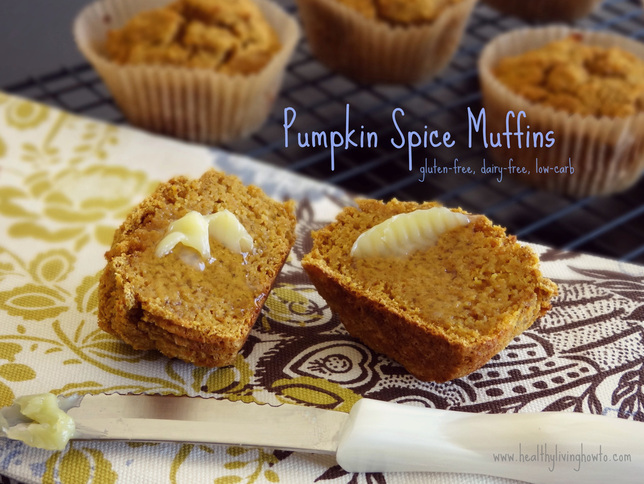At Costco over the weekend, I spotted a box of Krusteaz Pumpkin Spice Quick Bread. As I normally do, when I spot something new or seasonal on the shelf, I picked up the box to study the ingredient label. This particular box doesn't necessarily “scream” healthy, but I bet, if I would have stood there in the aisle randomly asking customers their opinion, chances are I'd get some yeses. After all it is made from pumpkin and “real” pecans, which may equal healthy for the unknowing. Just for fun, I'd thought we could dissect the label and then I'll share my recipe for healthy, gluten-free, dairy-free, low-carb, Pumpkin Spice Muffins.
A Lesson In Label Dissection
#1 Avoid foods that have some form of sugar listed among the top three ingredients.
#2 Avoid food products that contain more than five ingredients.
#3 Avoid food products containing ingredients that a third-grader cannot pronounce.
Michael Pollan, Food Rules An Eater's Manual
Ingredients: sugar, enriched bleached flour (wheat flour, niacin, reduced iron, thiamin mononirate, riboflavin, folic acid, may contain malted barley flour), canola or soybean oil, pecans, food starch-modified, dried pumpkin flakes, spices, salt, emulsifier (propylene glycol monoester, mono-diglycerides, sodium stearoyl lactylate), sodium bicarbonate, caramel color. Freshness preserved with BHA. Nutrition Facts: per serving 260 calories, 4g* fat, 36g carbohydrates, 1g dietary fiber, 21g sugar, 2g protein. (*This value is for the dry mix not prepared.)
Sugar
According to the FDA, the ingredient list on a food label is the listing of each ingredient in descending order of predominance.[1] Looking at the label for the Krustez Pumpkin Spice Bread that would tell us that sugar is the predominant ingredient by weight. By looking at the nutrition facts we see that per serving this equals 21 grams of sugar, which is roughly 5 teaspoons. When it comes to sugar in the bloodstream, the difference between having a normal blood sugar and a diabetic blood sugar is about a quarter of a teaspoon of sugar.[2]
Enriched Bleached Flour
Next up in weight we have enriched bleached wheat flour. Besides being a source of gluten, enriched wheat flour is technically no different from white flour. Manufacturers take wheat and chemically strip out naturally occurring vitamins and minerals, then add synthetic one's back in. Whether the body actually absorbs these synthetic chemicals is debatable.
Canola or Soybean Oil
We can't have sugar and flour without the fat. Canola and especially soybean oil, is used excessively in the current food supply. By weight, both canola and soybean oil are predominantly omega-6 fatty acids. Not only does an excessive amount of omega-6 fatty acids cause inflammation in the body, but these highly refined oils, are oftentimes unstable, rancid and oxidized. Rancid oils are a major source of destructive free radicals, which damage our cells and cause aging. To make matters worse, this issue is compounded by heat/cooking.
Food Starch-Modified
Modified food starch is made from grains, typically corn or wheat. The starch is acid-modified by treatment with hydrochloric acid or sulfuric acid or both and bleached with chlorine.[3] The starch retains its granular form and often resembles the original starch, but the modification results in improved properties. Modified food starches are used for a variety of different purposes, to retain moisture, to thicken and as a binding agent to name a few. The long-term health effects of this is unknown.
Emulsifier
We round out the ingredients with a bunch of additives and preservatives. Emulsifiers are food additives used to stabilize processed foods. Propylene glycol is a clear liquid used in antifreeze and de-icing solutions; our government has labeled this as GRAS, generally regarded as safe for use in food.[4] Propylene glycol is believed to be both toxic to the skin and the nervous system. Mono-diglycerides are one of the most widely used emulsifiers in food production. It is made from hydrogenated oils which are unhealthy trans-fats.
Caramel Color
Caramel color contains 4-MI which is a compound the state of California recently added to its known list of carcinogens.[5] This is what gives colas their brown color.
BHA
Finally, BHA is a widely used and highly controversial preservative in which a number of countries has restricted its use. It is thought to be both toxic to the nervous system and the liver.
[3] FDA Food Additives Permitted for Direct Addition to Food for Human Consumption
[4] CDC: Agency for Toxic Substances and Disease Registry
[5] NPR: Coco-Cola Modifies Caramel Color to Avoid Cancer Warning Label
Healthy Recipe: Pumpkin Spice Muffins
Pumpkin Spice Muffins
Prep Time: 10 minutes
Cook Time: 35 minutes
Makes: 6 muffins
Ingredients
- 1/4 c. Coconut Flour
- 1/4 c. Golden Flaxseed Meal
- 1/8 tsp. Celtic Sea Salt
- 1 tsp. Aluminum-Free Baking Powder
- 1 tsp. Cinnamon
- 1/2 tsp. Ground Ginger
- 1/8 tsp. Ground Nutmeg
- 1/8 tsp. Ground Cloves
- 3 Tbsp. Non-GMO Erythritol Granules + 1/16 tsp. Pure Stevia Extract Powder (this is the equivalent of 1/4 c. sweetness) OR 1/4 c. Birch Xylitol OR 1/4 c. Swerve
- 2 Large Organic Eggs
- 1/2 c. Canned Pumpkin Puree
- 1 tsp. Unsulphured Blackstrap Molasses (optional)
- 1 tsp. Vanilla Extract
- 1 Tbsp. Extra Virgin Coconut Oil, Melted
Directions
- In a medium bowl, sift together coconut flour, flaxseed meal, salt, baking powder, cinnamon, ginger, nutmeg, cloves, and sweetener.
- In a separate bowl whisk together eggs, pumpkin, molasses and vanilla.
- Add wet ingredients to dry ingredients and mix until well incorporated.
- Drizzle batter with melted coconut oil and mix one final time.
- Spoon batter into 6 muffin tins lined with non-stick liners. (If You Care are truly non-stick!)
- Bake at 350°F for 35 minutes or until toothpick inserted in center comes out clean.
For a Recipe Twist
Add 1/2 cup frozen cranberries that have been roughly chopped. Even more amazing!
Nutritional Comparison
|
Fat 15g 6g |
Carbs 36g 7g |
Fiber 1g 4g |
Protein 2g 5g |

